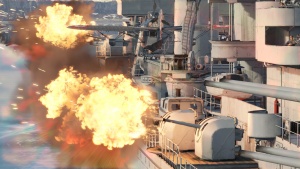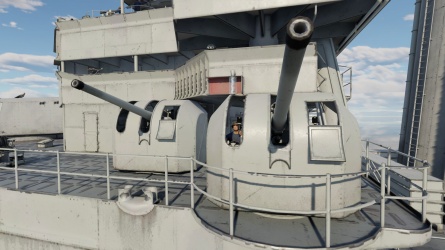90 mm/50 model 1926 (90 mm)
Contents
Description
The 90 mm/50 Modèle 1926 is a light dual-purpose gun, designed in 1926, and entered service in 1931 as a replacement for the 75 mm/50. It was designed to deliver a long-range barrage of flak fire, protecting the fleet from level bombers and torpedo planes long before they became a real threat. Despite its higher calibre, the 75 mm could be replaced in a 1:1 ratio with the 90 mm, and the new gun maintained the same rate of fire.
The 90 mm/50 model 1926 is best used as a dedicated secondary anti-aircraft gun. While it has the capability to engage surface targets, especially coastal boats, it is hindered by the lack of armour-piercing shells.
Vehicles equipped with this weapon
General info
Tell us about the tactical and technical characteristics of the cannon or machine gun.
Available ammunition
| Penetration statistics | |||||||
|---|---|---|---|---|---|---|---|
| Ammunition | Type of warhead |
Penetration @ 0° Angle of Attack (mm) | |||||
| 100 m | 1,000 m | 2,000 m | 3,000 m | 4,000 m | 5,000 m | ||
| OEA Mle 1925 HE | HE | 13 | 13 | 13 | 13 | 13 | 13 |
| OEA Mle 1925 HE-TF | HE-TF | 13 | 13 | 13 | 13 | 13 | 13 |
| Shell details | ||||||||||||
|---|---|---|---|---|---|---|---|---|---|---|---|---|
| Ammunition | Type of warhead |
Velocity (m/s) |
Projectile mass (kg) |
Fuse delay (m) |
Fuse sensitivity (mm) |
Explosive mass (TNT equivalent) (g) |
Ricochet | |||||
| 0% | 50% | 100% | ||||||||||
| OEA Mle 1925 HE | HE | 850 | 9.5 | 0 | 0.1 | 905 | 79° | 80° | 81° | |||
| OEA Mle 1925 HE-TF | HE-TF | 850 | 9.5 | 0 | 0.1 | 905 | 79° | 80° | 81° | |||
Comparison with analogues
Give a comparative description of cannons/machine guns that have firepower equal to this weapon.
Usage in battles

The 90 mm/50 model 1926 is an excellent dual-purpose gun, able to engage even dive bombers thanks to its +80° vertical guidance. HE-TF rounds are the preferred first choice for the secondaries, as they maximise the chance of damaging an enemy aeroplane, either by a direct hit or shrapnel from a nearby explosion. HE-TF rounds can also be used against coastal vessels, as at short range they will function like regular HE shells, though switching to anti-aircraft armament can be a better choice when engaging small, manoeuvring torpedo boats.
The gun, lacking AP or SAP shells, will struggle to destroy heavier targets, such as destroyers or cruisers.
Pros and cons
Pros:
- Good targeting speed
- Large explosive filler
Cons:
- No access to AP or HE-VT shells
History
Examine the history of the creation and combat usage of the weapon in more detail than in the introduction. If the historical reference turns out to be too long, take it to a separate article, taking a link to the article about the weapon and adding a block "/History" (example: https://wiki.warthunder.com/(Weapon-name)/History) and add a link to it here using the main template. Be sure to reference text and sources by using <ref></ref>, as well as adding them at the end of the article with <references />.
Media
Excellent additions to the article would be video guides, screenshots from the game, and photos.
See also
- 75 mm/50 model 1922 (Predecessor)
- 8.8 cm/76 SK C/32 (German equivalent)
- 100 mm/47 O.T.O. Mod. 1928 (Italian equivalent)
- 4 in QF Mark V (British equivalent)
External links
- [Wikipedia] Canon de 90 mm Modèle 1926
- [NavWeaps] France 90 mm/50 (3.5") Model 1926
- French Cruisers 1922-1956 by John Jordan & Jean Moulin, page 65
| France naval cannons | |
|---|---|
| 37 mm | 37 mm/50 model 1925 · 37 mm/50 model 1933 |
| 47 mm | 3 pdr QF Hotchkiss |
| 57 mm | 57 mm/60 ACAD Mle 1951 |
| 75 mm | 75 mm/50 Canet model 1891 · 75 mm/50 model 1922 |
| 90 mm | 90 mm/50 model 1926 |
| 130 mm | 130 mm/40 model 1919 |
| 138.6 mm | 138.6 mm/55 model 1910 · 138.6 mm/40 model 1927 · 138.6 mm/50 model 1929 · 138.6 mm/50 model 1934 R1938 |
| 152 mm | 152 mm/55 model 1930 |
| 155 mm | 155 mm/50 model 1920 |
| 203 mm | 203 mm/50 model 1924 |
| 305 mm | 305 mm/45 model 1906-10 |
| 340 mm | 340 mm/45 model 1912 |
| Foreign: | |
| 20 mm | 2 cm/65 C/38 (Germany) · 2 cm/65 Flakvierling 38 (Germany) · 20 mm/70 Oerlikon Mk.II (USA/Britain) |
| 40 mm | 2pdr QF Mk.IIc (Britain) · 2pdr QF Mk.VIII (Britain) · Bofors L/60 Mark 2 (USA) · Bofors L/60 Mark 3 (USA) |
| 87.6 mm | Ordnance QF 25pdr (87.6 mm) (Britain) |
| 102 mm | 4 in QF Mark V (Britain) · 4 inch/45 Mark XVI (Britain) |
| 105 mm | SK C/33 AA (Germany) |
| 128 mm | 12.8 cm/45 SK C/34 (Germany) |
| 150 mm | 15 cm/48 KC/36 (Germany) |




